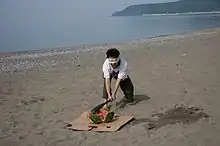Suikawari (スイカ割り, suika-wari, lit. Watermelon Splitting) is a traditional Japanese game that involves splitting a watermelon with a stick while blindfolded. Played in the summertime, suikawari is most often seen at beaches, but also occurs at festivals, picnics, and other summer events.


The rules are similar to piñata. A watermelon is laid out, and participants one by one attempt to smash it open. Each is blindfolded, spun around three times, and handed a wooden stick, or bokken, to strike with. The first to crack the watermelon open wins. Other participants or teammates may also give the player hints such as left/right or straight ahead.
Afterwards the chunks of watermelon produced are shared among participants. Because the watermelon can fall into the sand and get dirty, a sheet, a piece of cardboard, or other element is commonly placed beneath it.
"Official" "rules"
Japan Suika-Wari Association Rules
The Japan Suika-Wari Association (JSWA), established by the Japan Agricultural Cooperative (JA), established a set of rules in 1991 governing the game.[1] The JSWA was created by the JA to increase consumption of watermelon. The organization no longer exists. The rules established were as follows:
- Distance between player and watermelon: over 5m, and within 7m
- Stick: Circumference of 5cm; length equal to or less than 120cm.
- Material to use for blindfold: JSWA-recognized blindfolds. To verify that the player was truly blinded, observers were encouraged to drop a 10,000-yen note in front of her.
- Watermelon: a well-ripened domestic melon.
- Time limit: 3 minutes.
- Judging: Judges should rate the player on how pretty a break between halves she managed to make. Players who cleaved the watermelon in equal halves could come close to a perfect score, while players who broke them into unequal parts would receive lower marks.
- Other details: Judges should have eaten at least 10 watermelons in the current year.
See also
References
- ↑ ”スイカ割りのルール”. Michinoku-Murayama Agricultural Cooperative Association Web site. http://www.mitinoku.or.jp/tokusan/suika_wari.htm